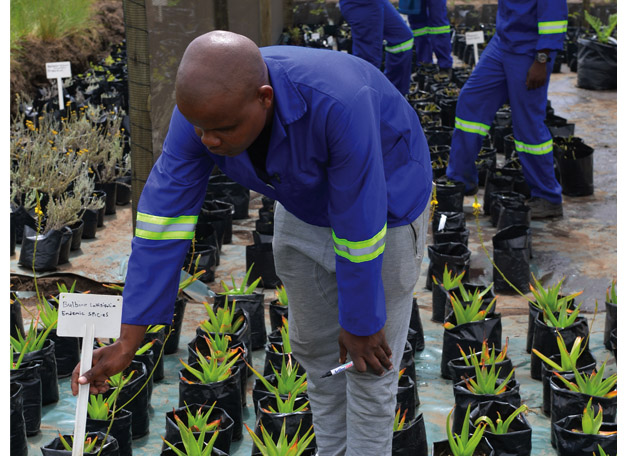Plant search and rescue on Wild Coast project
Search and rescue for threatened or protected flora species on the N2WCR’s Mtentu Bridge comprised site visits by botanists, traditional healers, an ecologist, and the project’s Environmental Monitoring Committee (EMC). They surveyed the site and geotagging.
The search and rescue sections included haul roads and the accompanying N2 road reserve, bridge sites, access roads, Mtentu Bridge site camps, house relocation sites and the forest section near to pier 9 of the Mtentu Bridge.
The latest search and rescue report, ending in December 2018 outlines that a total of 14 365 plant bags had been rescued from 71 grassland species on the Mtentu North side. There were 13 337 plant bags rescued from 31 forest species. On the Mtentu South side there were 15 016 plant bags rescued from 85 species. A total of 268 wetland and grassland veld sods were rescued between the Mtentu North and South sites. There was a total of 2 956.3kg of

grass seed harvested at Mtentu North and South from 16 species until the end of September 2018 to ensure enough seed stock is on hand for the rehabilitation phases of the greenfields project.
Due to the extended protest that started on 22 October last year, no watering and maintenance of plants in two temporary holding facilities was possible, resulting in the loss of substantial number of rescued plants. The site was reopened on 14 January 2019. A survey of plants in the holding facilities showed just more than 60% of the plants survived. Rainfall in December and January contributed to the survival of the plants.
No search and rescue activities had taken place in January and February 2019 due to the absence of the civil contractor on site.
Propagation of collected seeds is in progress on an off-site location to ensure a high diversity of species is available for rehabilitation.
Strict environmental rules to follow on N2 Wild Coast project
The Environmental Record of Decision for the construction of the N2 Wild Coast Road was granted with a large number of strict requirements to ensure the impact of the road is always avoided or minimised as far as possible, and mitigation measures are put in place to off-set the residual impact.
There is an environmental management programme in place that requires all appointed contractors to adhere to or else fines are issued for non-compliance.
In July 2018, SANRAL held engagements with the Eastern Cape Parks & Tourism Agency (ECPTA) regarding fast tracking implementation of the Biodiversity Offset Agreement for the N2 Wild Coast Route project.
The EMC site visit was held on 14 August 2018 at Mtentu North. The quarterly Authorities
Coordinating Committee (ACC) and EMC meetings were held on 14 November 2018 and 27 February 2019 to report back on the implementation of the Biodiversity Offset Agreement (BOA) of the N2WCR project and the search and rescue mission, the outcome of compliance audits conducted, among other matters.

On 7 March 2019, the High Court (Gauteng Division) ruled in favour of SANRAL in the application to review and set aside the granting of environmental authorisation to proceed with the N2 Wild Coast road project. The application was denied and the presiding judge stated that the public participation process to inform and canvass input from affected persons in the area was “one of the most comprehensive”.
BUILDING SOUTH AFRICA THROUGH BETTER ROADS
N2 WILD COAST 2019